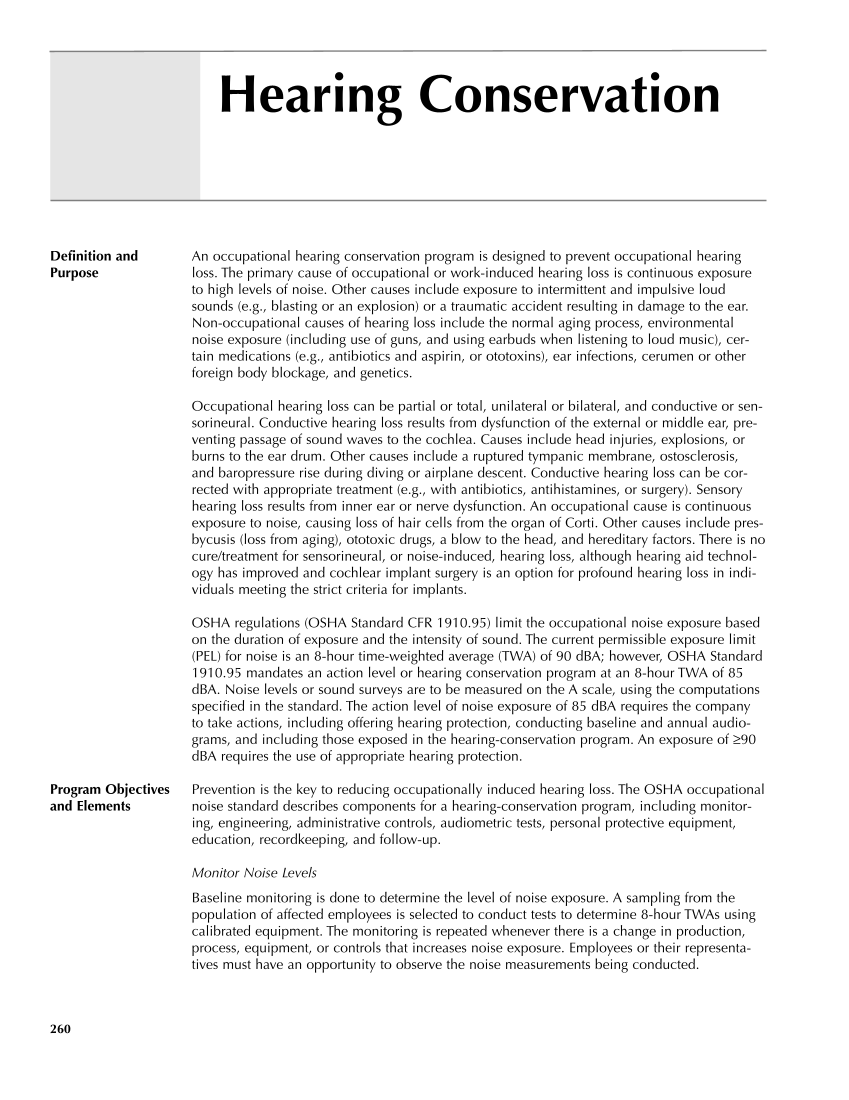An occupational hearing conservation program is designed to prevent occupational hearing loss. The primary cause of occupational or work-induced hearing loss is continuous exposure to high levels of noise. Other causes include exposure to intermittent and impulsive loud sounds (e.g., blasting or an explosion) or a traumatic accident resulting in damage to the ear. Non-occupational causes of hearing loss include the normal aging process, environmental noise exposure (including use of guns, and using earbuds when listening to loud music), cer- tain medications (e.g., antibiotics and aspirin, or ototoxins), ear infections, cerumen or other foreign body blockage, and genetics. Occupational hearing loss can be partial or total, unilateral or bilateral, and conductive or sen- sorineural. Conductive hearing loss results from dysfunction of the external or middle ear, pre- venting passage of sound waves to the cochlea. Causes include head injuries, explosions, or burns to the ear drum. Other causes include a ruptured tympanic membrane, ostosclerosis, and baropressure rise during diving or airplane descent. Conductive hearing loss can be cor- rected with appropriate treatment (e.g., with antibiotics, antihistamines, or surgery). Sensory hearing loss results from inner ear or nerve dysfunction. An occupational cause is continuous exposure to noise, causing loss of hair cells from the organ of Corti. Other causes include pres- bycusis (loss from aging), ototoxic drugs, a blow to the head, and hereditary factors. There is no cure/treatment for sensorineural, or noise-induced, hearing loss, although hearing aid technol- ogy has improved and cochlear implant surgery is an option for profound hearing loss in indi- viduals meeting the strict criteria for implants. OSHA regulations (OSHA Standard CFR 1910.95) limit the occupational noise exposure based on the duration of exposure and the intensity of sound. The current permissible exposure limit (PEL) for noise is an 8-hour time-weighted average (TWA) of 90 dBA however, OSHA Standard 1910.95 mandates an action level or hearing conservation program at an 8-hour TWA of 85 dBA. Noise levels or sound surveys are to be measured on the A scale, using the computations specified in the standard. The action level of noise exposure of 85 dBA requires the company to take actions, including offering hearing protection, conducting baseline and annual audio- grams, and including those exposed in the hearing-conservation program. An exposure of ≥90 dBA requires the use of appropriate hearing protection. Prevention is the key to reducing occupationally induced hearing loss. The OSHA occupational noise standard describes components for a hearing-conservation program, including monitor- ing, engineering, administrative controls, audiometric tests, personal protective equipment, education, recordkeeping, and follow-up. Monitor Noise Levels Baseline monitoring is done to determine the level of noise exposure. A sampling from the population of affected employees is selected to conduct tests to determine 8-hour TWAs using calibrated equipment. The monitoring is repeated whenever there is a change in production, process, equipment, or controls that increases noise exposure. Employees or their representa- tives must have an opportunity to observe the noise measurements being conducted. 260 Definition and Purpose Program Objectives and Elements Hearing Conservation
Purchased from OEM Press by (ge corporate access). (C) 2013 OEM Health Information, Inc. All rights reserved.












































































































































































































































































































































































































































